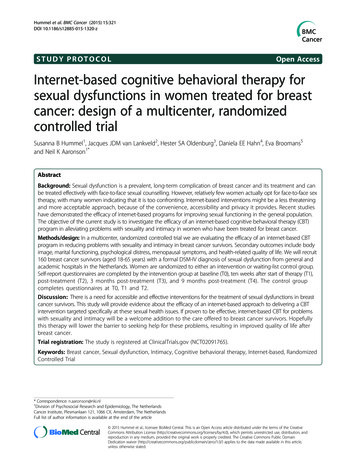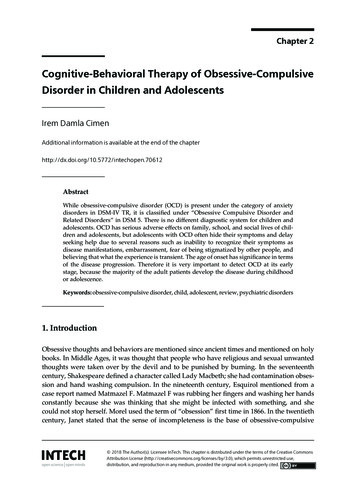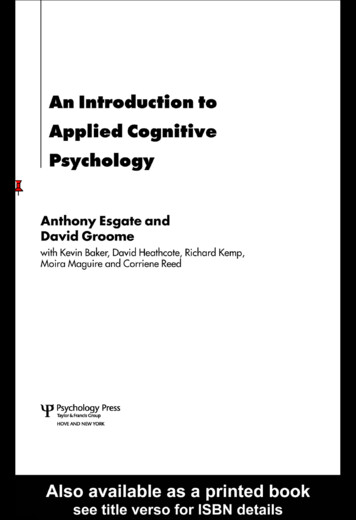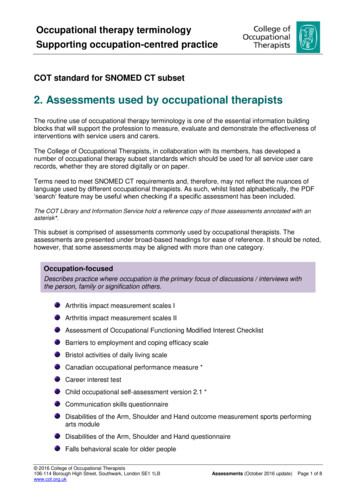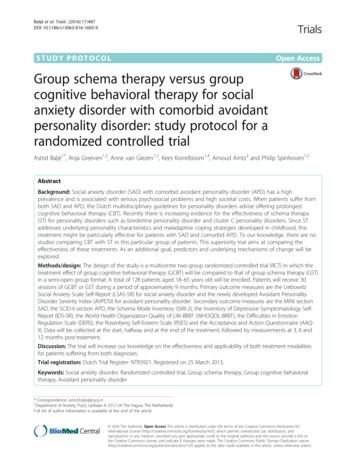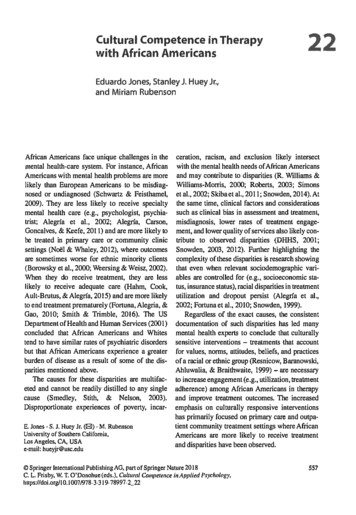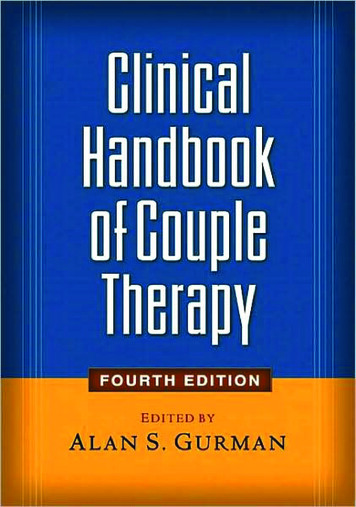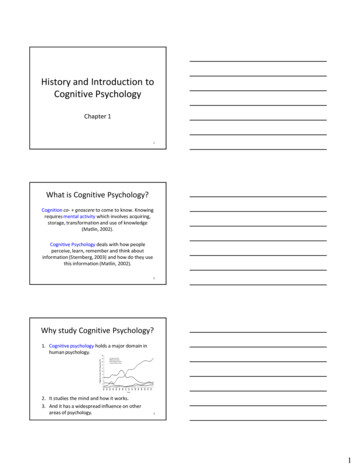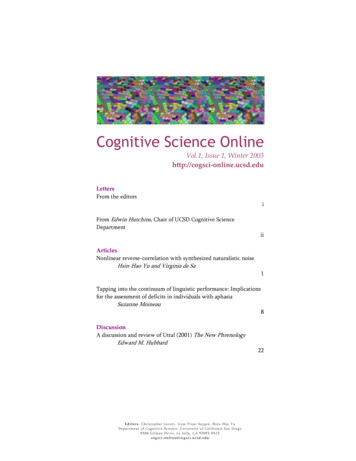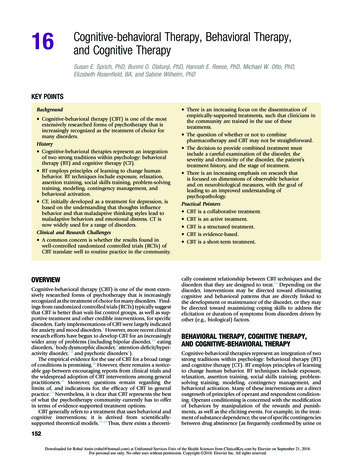
Transcription
16Cognitive-behavioral Therapy, Behavioral Therapy,and Cognitive TherapySusan E. Sprich, PhD, Bunmi O. Olatunji, PhD, Hannah E. Reese, PhD, Michael W. Otto, PhD,Elizabeth Rosenfield, BA, and Sabine Wilhelm, PhDKEY POINTSBackground Cognitive-behavioral therapy (CBT) is one of the mostextensively researched forms of psychotherapy that isincreasingly recognized as the treatment of choice formany disorders.History Cognitive-behavioral therapies represent an integrationof two strong traditions within psychology: behavioraltherapy (BT) and cognitive therapy (CT). BT employs principles of learning to change humanbehavior. BT techniques include exposure, relaxation,assertion training, social skills training, problem-solvingtraining, modeling, contingency management, andbehavioral activation. CT, initially developed as a treatment for depression, isbased on the understanding that thoughts influencebehavior and that maladaptive thinking styles lead tomaladaptive behaviors and emotional distress. CT isnow widely used for a range of disorders.Clinical and Research Challenges A common concern is whether the results found inwell-controlled randomized controlled trials (RCTs) ofCBT translate well to routine practice in the community.OVERVIEWCognitive-behavioral therapy (CBT) is one of the most extensively researched forms of psychotherapy that is increasinglyrecognized as the treatment of choice for many disorders.1 Findings from randomized controlled trials (RCTs) typically suggestthat CBT is better than wait-list control groups, as well as supportive treatment and other credible interventions, for specificdisorders. Early implementations of CBT were largely indicatedfor anxiety and mood disorders.2 However, more recent clinicalresearch efforts have begun to develop CBT for an increasinglywider array of problems (including bipolar disorder,3,4 eatingdisorders,5 body dysmorphic disorder,6 attention-deficit/hyperactivity disorder,7,8 and psychotic disorders9).The empirical evidence for the use of CBT for a broad rangeof conditions is promising.10 However, there remains a noticeable gap between encouraging reports from clinical trials andthe widespread adoption of CBT interventions among generalpractitioners.11 Moreover, questions remain regarding thelimits of, and indications for, the efficacy of CBT in generalpractice.12 Nevertheless, it is clear that CBT represents the bestof what the psychotherapy community currently has to offerin terms of evidence-supported treatment options.CBT generally refers to a treatment that uses behavioral andcognitive interventions; it is derived from scientificallysupported theoretical models.13,14 Thus, there exists a theoreti- There is an increasing focus on the dissemination ofempirically-supported treatments, such that clinicians inthe community are trained in the use of thesetreatments. The question of whether or not to combinepharmacotherapy and CBT may not be straightforward. The decision to provide combined treatment mustinclude a careful examination of the disorder, theseverity and chronicity of the disorder, the patient’streatment history, and the stage of treatment. There is an increasing emphasis on research thatis focused on dimensions of observable behaviorand on neurobiological measures, with the goal ofleading to an improved understanding ofpsychopathology.Practical Pointers CBT is a collaborative treatment. CBT is an active treatment. CBT is a structured treatment. CBT is evidence-based. CBT is a short-term treatment.cally consistent relationship between CBT techniques and thedisorders that they are designed to treat.15 Depending on thedisorder, interventions may be directed toward eliminatingcognitive and behavioral patterns that are directly linked tothe development or maintenance of the disorder, or they maybe directed toward maximizing coping skills to address theelicitation or duration of symptoms from disorders driven byother (e.g., biological) factors.BEHAVIORAL THERAPY, COGNITIVE THERAPY,AND COGNITIVE-BEHAVIORAL THERAPYCognitive-behavioral therapies represent an integration of twostrong traditions within psychology: behavioral therapy (BT)and cognitive therapy (CT). BT employs principles of learningto change human behavior. BT techniques include exposure,relaxation, assertion training, social skills training, problemsolving training, modeling, contingency management, andbehavioral activation. Many of these interventions are a directoutgrowth of principles of operant and respondent conditioning. Operant conditioning is concerned with the modificationof behaviors by manipulation of the rewards and punishments, as well as the eliciting events. For example, in the treatment of substance dependence, the use of specific contingenciesbetween drug abstinence (as frequently confirmed by urine or152Downloaded for Rohul Amin (rohul@hotmail.com) at Uniformed Services Univ of the Health Sciences from ClinicalKey.com by Elsevier on September 21, 2018.For personal use only. No other uses without permission. Copyright 2018. Elsevier Inc. All rights reserved.
Cognitive-behavioral Therapy, Behavioral Therapy, and Cognitive Therapysaliva toxicology screens) and rewards (e.g., the chance to wina monetary reward) has proven to be a powerful strategy forachieving abstinence among chronic drug abusers.16 Includedas an operant strategy are also the myriad of interventions thatuse stepwise training to engender needed new skills forproblem situations. For example, assertiveness training, relaxation training, and problem-solving training are all core behavioral strategies for intervening with skill deficits that may bemanifest in disorders as diverse as depression, bipolar disorder, or hypochondriasis. One approach to treating depression,behavioral activation, emphasizes the return to pleasurableand productive activities, and the specific use of these activitiesto boost mood. Interventions involve the step-by-step programming of activities rated by patients as relevant to theirpersonal values and likely to evoke pleasure or a sense ofpersonal productivity. Behavioral activation will typicallyconsist of construction of an activity hierarchy in which up to(approximately) 15 activities are rated, ranging from easiest tomost difficult to accomplish. The patient then moves throughthe hierarchy in a systematic manner, progressing from theeasiest to the most difficult activity.17 Depending on thepatient, additional interventions or skill development may beneeded. For example, assertion training may include a varietyof interventions, such as behavioral rehearsal, which is actingout appropriate and effective behaviors, to manage situationsin which assertiveness is problematic.Respondent conditioning refers to the changing of themeaning of a stimulus through repeated pairings with otherstimuli, and respondent conditioning principles have beenparticularly applied to interventions for anxiety disorders. Forexample, influential theories such as Mowrer’s18 two-factortheory of phobic disorders emphasized the role of respondentconditioning in establishing fearful responses to phobic cues,and the role of avoidance in maintaining the fear. Accordingly,BT focuses on the role of exposure to help patients re-enterphobic situations and to eliminate (extinguish) learned fearsabout these phobic stimuli through repeated exposure to themunder safe conditions. Exposure treatments may include anynumber of modalities or procedures. For example, a patientwith social phobia may be exposed to a series of social situations that elicit anxiety, including in vivo exposure (e.g., talkingon the phone, talking with strangers, giving a speech), imaginal exposure (e.g., imagining themselves in a social situation),exposure to feared sensations (termed interoceptive exposurebecause exposure involves the elicitation of feared somaticsensations, typically sensations similar to those of anxiety andpanic), and exposure to feared cognitions (e.g., exposure tofeared concepts using imaginal techniques). Exposure is generally conducted in a graduated fashion, in contrast to flooding,in which the person is thrust into the most threatening situation at the start. Exposure is designed to help patients learnalternative responses to a variety of situations by allowing fearto dissipate (become extinguished) while remaining in thefeared situation. Once regarded as a passive weakening oflearned exposures, extinction is now considered an activeprocess of learning an alternative meaning to a stimulus (e.g.,relearning a sense of “safety” with a once-feared stimulus),19and ongoing research on the principles, procedures, and limitsof extinction as informed by both animal and human studieshas the potential for helping clinicians further hone in on theefficacy of their exposure-based treatments. For example, thereis increasing evidence that the therapeutic effects of exposureare maximized when patients are actively engaged in, andattentive to, exposure-based learning; when exposure is conducted in multiple, realistic contexts; and when patients areprovided with multiple cues for safety learning.20 Therapistsshould also ensure that the learning that occurs during exposure is independent of contexts that will not be present in the153future (e.g., the presence of the therapist). Effective applicationof exposure therapy also requires prevention of safety behaviors that may undermine what is learned from exposure. Safetybehaviors refer to those behaviors that individuals may use toreassure themselves in a phobic situation. For example, apatient with panic disorder may carry a cell phone or a waterbottle for help or perceived support during a panic attack.These safety behaviors, while providing reassurance to patients,appear to block the full learning of true safety.21,22 That is,when such safety behaviors are made unavailable, betterextinction (safety) learning appears to result.23,24CT was initially developed as a treatment for depressionwith the understanding that thoughts influence behavior andit is largely maladaptive thinking styles that lead to maladaptive behavior and emotional distress.25,26 Currently, however,CT includes approaches to a wider range of disorders.27,28As applied to depression, the cognitive model posits thatintrusive cognitions associated with depression arise froma synthesis of previous life experiences. The synthesis ofsuch experiences is also described as a schema, a form ofsemantic memory that describes self-relevant characteristics.For example, the cognitive model of depression posits thatnegative “schemas” about the self that contain absolute beliefs(e.g., “I am unlovable” or “I am incompetent”) may result indysfunctional appraisals of the self, the world, and the future.On exposure to negative life events, negative schemas anddysfunctional attitudes are activated that may produce symptoms of depression. Thus, maladaptive cognitive patterns andnegative thoughts may also be considered risk or maintainingfactors for depression.29 Negative automatic thoughts can becategorized into a number of common patterns of thoughtreferred to as cognitive distortions. As outlined in Table 16-1,cognitive distortions often occur automatically and may manifest as irrational thoughts or as maladaptive interpretations ofrelatively ambiguous life events.CT,30 and a similar approach known as rational-emotivetherapy,31 provides techniques that correct distorted thinkingand offer a means by which patients can respond to maladaptive thoughts more adaptively. In addition to examining cognitive distortions (see Hollon and Garber32 and Table 16-1),CT focuses on more pervasive core beliefs (e.g., “I am unlovable” or “I am incompetent”) by assessing the themes that liebehind recurrent patterns of cognitive distortions. Thosethemes may be evaluated with regard to a patient’s learninghistory (to assess the etiology of the beliefs with the goal oflogically evaluating and altering the maladaptive beliefs).A commonly used cognitive technique is cognitive restructuring. Cognitive restructuring begins by teaching a patientabout the cognitive model and by providing a patient withtools to recognize (negative) automatic thoughts that occur“on-line”. Most therapists use a daily log or a diary to monitornegative automatic thoughts. Some patients find it convenientto do this work using an “app” on their smart phone or usingtheir tablet or laptop computer. The next step in cognitiverestructuring is to provide the patient with opportunities toevaluate his or her thoughts with respect to their usefulness,as well as their validity. Through the process of logically analyzing thoughts, a patient is provided with a unique contextfor replacing distorted thoughts with more accurate and realistic thoughts. One method for helping a patient engage incritical analysis of thinking patterns is to consider the objectiveevidence for and against the patient’s maladaptive thoughts.Thus, questions such as, “What is the evidence that I am a badmother? What is the evidence against it?” might be asked.Another useful technique places the patient in the role ofadviser.30 In the role of adviser, a patient is asked what advicehe or she might give a family member or friend in the samesituation. By distancing the patient from his or her ownDownloaded for Rohul Amin (rohul@hotmail.com) at Uniformed Services Univ of the Health Sciences from ClinicalKey.com by Elsevier on September 21, 2018.For personal use only. No other uses without permission. Copyright 2018. Elsevier Inc. All rights reserved.16
154PART IV The PsychotherapiesTABLE 16-1 Examples of Cognitive kingMental filterLooking at things in absolute, black-andwhite categoriesDwelling on the negatives and ignoring thepositivesInsisting that accomplishments or positivequalities “don’t count”Assuming that people are reactingnegatively to you when there is noevidence to support the assumptionsMaking a negative conclusion that goes farbeyond the current situationArbitrarily predicting that things will turn outbadlyBlowing things out of proportion or shrinkingtheir importance inappropriatelyReasoning from how you feel (“I feel stupid,so I must really be stupid”)Criticizing yourself (or others) with “shoulds”or “shouldn’ts,” “musts,” “oughts,” and“have-tos”Identifying with shortcomings (“I’m a loser”)Blaming yourself for something you weren’tresponsible for (and not considering moreplausible explanations)Discounting thepositivesMind tion orminimizationEmotional reasoning“Should” statementsLabelingPersonalization andblameTABLE 16-2 Examples of Well-Established Cognitive, Behavioral,and Cognitive-Behavioral Treatments for Specific ioralDepressionAgoraphobiaDepressionSocial phobiaSpecific phobiaObsessive-compulsive disorderHeadacheOppositional behaviorEnuresisMarital dysfunctionFemale orgasmic dysfunctionMale erectile dysfunctionDevelopmental disabilitiesPanic, with and without agoraphobiaGeneralized anxiety disorderSocial phobiaIrritable bowel syndromeChronic painBulimiaCognitive-behavioralAdapted from Chambless DL, Baker MJ, Baucom DH, et al. Updateon empirically validated therapies: II, Clin Psychol 51:3–16, 1998.41Adapted from Beck JS. Cognitive behavior therapy: basics andbeyond, ed 2, New York, 2011, Guilford Press.30maladaptive thinking, the patient is given the opportunity toengage in a more rational analysis of the issue. These techniques allow patients to test the validity and utility of theirthoughts; as they evaluate their thinking and see things morerationally, they are able to function better. In addition totechniques for changing negative thinking patterns, CT alsoincorporates behavioral experiments. Behavioral tasks andexperiments are employed in CT to provide corrective data thatwill challenge beliefs and underlying negative assumptions.Concerning the mechanism of relapse prevention in CT,there is growing attention to the importance of the processingand form of negative thoughts, not just their content.33,34Studies suggest that cognitive interventions may be useful forhelping patients gain perspective on their negative thoughtsand feelings so that these events are not seen as “necessarilyvalid reflections of reality” (Teasdale et al.,33 p. 285). Indeed,there is evidence that changes in meta-cognitive awarenessmay mediate the relapse prevention effects of CT.33,35 Accordingly, shifting an individual’s emotional response to cognitions may be an important element of the strong relapseprevention effects associated with CT.36Although CT was initially developed to focus on challenging depressive distortions, basic maladaptive assumptions arealso observed in a wide range of other conditions, with thedevelopment of CT approaches ranging from panic disorder,37post-traumatic stress disorder (PTSD),38 social phobia,39 andhypochondriasis,28 to personality disorders27 and the prevention of suicide.40PUTTING BEHAVIORAL THERAPY ANDCOGNITIVE THERAPY TOGETHERAs a functional unification of cognitive and behavioral interventions, CBT relies heavily on functional analysis of inter related chains of thoughts, emotions, and behavior. Thus, theprinciples that underlie CBT are easily exportable to a widerange of behavioral deficits. As outlined in Table 16-2,41 CT,BT, and their combination have garnered empirical supportfor the treatment of a wide range of disorders. CBT has becomeincreasingly specialized in the last decade, and advances in theconceptualization of various disorders have brought a refinement of CBT interventions to target core features and dominant behavior patterns that characterize various disorders.Basic Principles of Cognitive-behavioralTherapyAs outlined in Table 16-3, contemporary CBT is a collaborative, structured, and goal-oriented intervention.1 The currentforms of CBT target core components of a given disorder. Forexample, CBT interventions for panic disorder target catastrophic misinterpretations of somatic sensations of panicand their perceived consequences, while exposure proceduresfocus directly on the fear of somatic sensations. Likewise, CBTfor social phobia focuses on the modification of fears of anegative evaluation by others and exposure treatments emphasize the completion of feared activities and interactions withothers. For generalized anxiety disorder (GAD), CBT treatmentfocuses on the worry process itself, with the substitutionof cognitive restructuring and problem-solving for selfperpetuating worry patterns, and the use of imaginal exposurefor worries and fears. In the case of depression, CBT targetsnegative thoughts about the self, the world, and the future, aswell as incorporating behavioral activation to provide moreopportunities for positive reinforcement. Symptom management strategies (e.g., breathing re-training or muscle relaxation) or social skills training (e.g., assertiveness training) arealso valuable adjuncts to exposure and to cognitive restructuring interventions.The Basic Practice ofCognitive-behavioral TherapyCBT is typically targeted toward short-term treatment, often inthe range of 12 to 20 sessions, although even shorter treatments, emphasizing the core mechanisms of change, haveDownloaded for Rohul Amin (rohul@hotmail.com) at Uniformed Services Univ of the Health Sciences from ClinicalKey.com by Elsevier on September 21, 2018.For personal use only. No other uses without permission. Copyright 2018. Elsevier Inc. All rights reserved.
Cognitive-behavioral Therapy, Behavioral Therapy, and Cognitive TherapyTABLE 16-3 Characteristic Features of Cognitive-behavioral TherapyFeatureDescriptionCBT is short termThe length of therapy in CBT is largelydependent on the time needed to help thepatient develop more adaptive patters ofresponding. However, CBT treatmentsgenerally involve approximately 8 to 20sessions.CBT provides a context for learning adaptivebehavior. It is the therapist’s role to providethe patient with the information, skills, andopportunity to develop more adaptivecoping mechanisms. Thus, homework is acentral feature of CBT.CBT is agenda-driven such that portions ofsessions are dedicated to specific goals.Specific techniques or concepts are taughtduring each session. However, eachsession should strike a balance betweenmaterial introduced by the patient and thepredetermined session agenda.The therapeutic relationship is generally lessof a focus in CBT. However, it is importantthat the therapist and patient have a goodcollaborative working relationship in orderto reduce symptoms by developingalternative adaptive skills.CBT is activeCBT is structuredCBT is collaborativeCBT, Cognitive-behavioral therapy.been developed.42 Treatment begins with a thorough evaluation of the problem for which the patient is seeking treatment.This generally consists of a very detailed functional analysis ofthe patient’s symptoms and the contexts in which they occur.This assessment requires extensive history-taking, a diagnosticinterview, analysis of current function (e.g., social, occupational, relational, and family), and assessment of socialsupport. Although the assessment may require some consideration of past events, such information is generally gatheredif it is directly relevant to the solution of here-and-nowproblems.A key feature of CBT involves the establishment of a strong,collaborative working alliance with the patient. This is ofteninitiated in the context of educating the patient about thenature of his or her disorder, explaining the CBT model of theetiology and maintenance of the disorder, and the intervention that is derived from the model. Educating the patientserves the function of normalizing aspects of the disorder; thiscan help to reduce self-blame. Psychoeducation (includinginformation on the course of treatment) may also enhancepatient motivation for change. The therapist and patient alsowork together to develop clear, realistic treatment goals.To gather information on the patient’s symptoms, thepatient is taught early on how to monitor his or her thoughtsand behaviors. This usually requires that the patient documenthis or her symptoms, as well as the time, date, and the levelof distress and the precursors and consequences of symptoms.Self-monitoring helps a patient become aware of the timingand occurrence of target symptoms, and provides additionalinformation on opportunities for intervention. Self-monitoringprocedures are vital to help a patient identify the content ofhis or her thoughts; once these thoughts have been identified,they can be challenged for their accuracy and utility. The accuracy of thoughts and beliefs is often examined in the contextof behavioral experiments, where patients have the opportunity to test out predictions (e.g., “I will pass out,” “I will notbe able to cope”).155CBT also emphasizes systematic monitoring of symptomchange. This may take the form of asking a patient how he orshe is feeling as compared to when in previous sessions.However, more standard CBT practice consists of having apatient fill out questionnaires about his or her symptoms.Periodic assessment of symptoms provides an objective lookat the nature of a patient’s symptoms relative to establishednorms, at which symptoms have improved, and at whichsymptoms require more attention. Essentially, objective assessment during CBT helps inform both the patient and the therapist about the efficacy of treatment and highlights furtherissues that require emphasis during the treatment. Monitoringoutcomes can also guide the clinician with regard to caseformulation or consideration of alternative CBT interventions,if expected treatment goals are not achieved.In many approaches to CBT, patient and therapist collaboratively set an agenda for topics to be discussed in each session.Particular attention is given to events that occurred since theprevious session that are relevant to the patient’s goals fortreatment. Part of the agenda for treatment sessions shouldfocus on the anticipation of difficulties that may occur beforethe next treatment session. These problems should then bediscussed in the context of problem-solving and the implementation of necessary cognitive and behavioral skills. Thismay require training in skills that readily facilitate the reduction of distress. Skills, such as training in diaphragmaticbreathing and progressive muscle relaxation, can be particularly useful in this regard. Although the specific interventionsused during CBT may vary, the decision about which interventions to use should be informed by cognitive and learningtheories that view disorders as understandable within a framework of reciprocally-connected behaviors, thoughts, and emotions that are activated and influenced by environmental andinterpersonal events.As indicated in Table 16-3, CBT is also an active treatmentwith an emphasis on home practice of interventions. Thus,review of homework is a major component of the CBT session.In reviewing the patient’s homework, emphasis should beplaced on what the patient learned, and what the patient wantsto continue doing during the coming week for homework. Thehomework assignment, which is collaboratively set, shouldfollow naturally from the problem-solving process in the treatment session. The use of homework in CBT draws from theunderstanding of therapy as a learning experience in whichthe patient acquires new skills. At the end of each CBT treatment session, a patient should be provided with an opportunity to summarize useful interventions from the session. Thisshould also consist of asking the patient for feedback on thesession, and efforts to enhance memories of and the subsequent home application of useful interventions.43Relapse prevention skills are central to CBT as well. Byemphasizing a problem-solving approach in treatment, apatient is trained to recognize the early warning signs ofrelapse and is taught to be “his or her own therapist.” Evenafter termination, a patient often schedules “booster sessions”to review the skills learned in treatment. In addition, novelapproaches to relapse prevention, as well as treatment of residual symptoms, emphasize the application of CBT to the promotion of well-being rather than simply the reduction ofpathology.44,45The Practice of Cognitive-behavioral Therapy:The Case of Panic DisorderCBT for panic disorder generally consists of 12 to 15 sessions;it begins with an introduction of the CBT model of panicdisorder (Figure 16-1).46 The therapist begins by discussing thesymptoms of panic with the patient. The symptoms of panicDownloaded for Rohul Amin (rohul@hotmail.com) at Uniformed Services Univ of the Health Sciences from ClinicalKey.com by Elsevier on September 21, 2018.For personal use only. No other uses without permission. Copyright 2018. Elsevier Inc. All rights reserved.16
156PART IV The PsychotherapiesStressBiological diathesisAlarm ReactionRapid heart rate, heart palpitations,shortness of breath, smothering sensations,chest pain or discomfort, numbness or tinglingIncreased anxietyand fearConditionedfear of somaticsensationsCatastrophicmisinterpretationsof symptomsHypervigilance to symptomsAnticipatory anxietyMemory of past attacksFigure 16-1. Cognitive-behavioral model of panic disorder. (Adaptedfrom Otto MW, Pollack MH, Meltzer-Brody S, Rosenbaum JF.Cognitive-behavioral therapy for benzodiazepine discontinuation inpanic disorder patients, Psychopharmacol Bull 28:123–130, 1992.)(e.g., rapid heart rate, shortness of breath, and trembling) areexplained as part of our body’s natural defense system thatprepares us for fight or flight in the presence of a real threat.When these symptoms occur in the presence of a real danger,the response helps us survive. When the symptoms occur inthe absence of a real danger, the response is a panic attack.Often when a person experiences a panic attack “out of theblue,” he or she fears that something is terribly wrong. Theperson fears that he or she may be having a heart attack, maybe seriously ill, or may be “going crazy.” Patients are told thatthese catastrophic misinterpretations of the symptoms ofpanic disorder serve to maintain the disorder. Such interpretations cause the individual to fear another attack; as a consequence, the person becomes hypervigilant for any somaticsensations that may signal the onset of an attack. This hypervigilance, in turn, heightens the individual’s awareness of hisor her body and increases somatic sensations that lead to moreanxiety. This cycle continues, culminating in a panic attack.Over the course of treatment, the therapist works with thepatient to examine the accuracy of catastrophic misinterpretations through Socratic questioning and provision of correctiveinformation. For example, the patient may be asked to evaluate the evidence for all of the likely consequences of a panicattack. Additionally, the patient is gradually exposed to thesomatic sensations that he or she fears (a process called interoceptive exposure). Interoceptive exposure consists of a widevariety of procedures (such as hyperventilation, exercise, orspinning in a chair47) meant to expose a patient to fearedinternal bodily experiences (e.g., tachycardia, numbness, ortingling) in a controlled fashion. Through repeated exposureto these sensations, a patient habituates to the sensations,which results in a decrease in fear and anxiety linked to internal stimuli. With repeated exposure, a patient learns that thesensations are not harmful.Cognitive restructuring is combined with interoceptiveexposure to aid the patient in reinterpreting the somatic sensations and reducing fear. For a patient with agoraphobia,gradual situational exposure is also conducted to eliminateavoidance of situations that have been associated with panic.In all exposure exercises, special attention must be paid to theelimination of safety behaviors that may interfere with habituatio
Cognitive-behavioral therapy (CBT) is one of the most extensively researched forms of psychotherapy that is increasingly recognized as the treatment of choice for many disorders. History Cognitive-behavioral therapies represent an integration ofo tw strong traditions within psychology: behavioral
